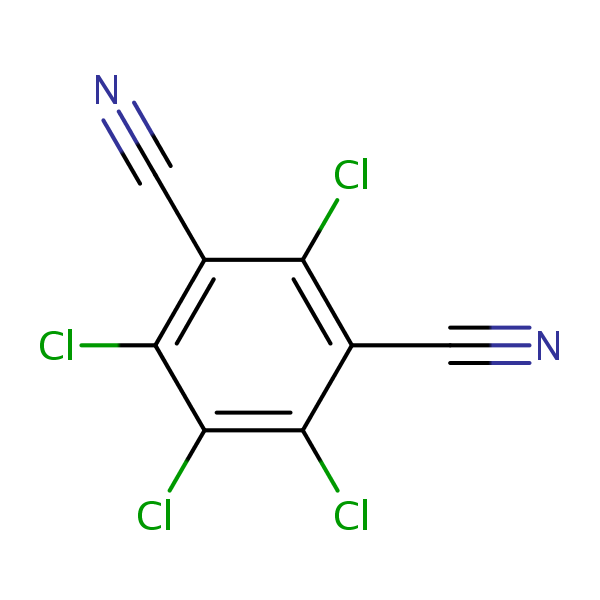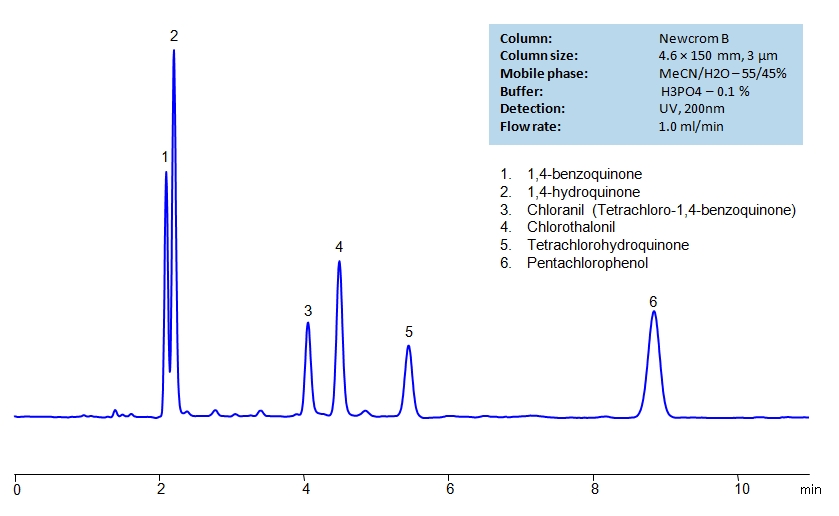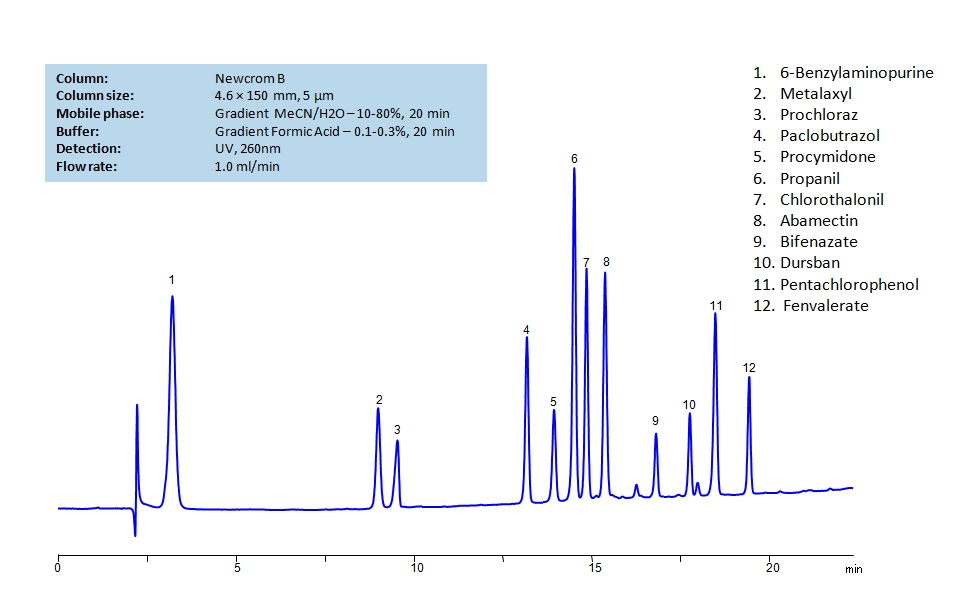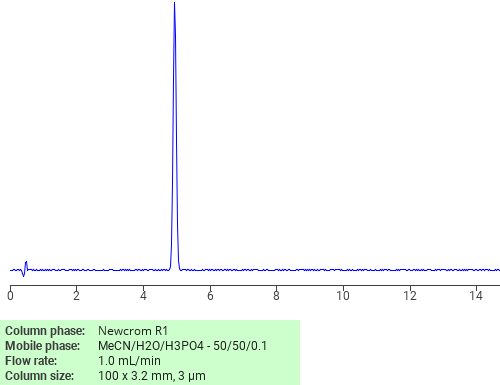| CAS Number | 1897-45-6 |
|---|---|
| Molecular Formula | C8Cl4N2 |
| Molecular Weight | 265.900 |
| InChI Key | CRQQGFGUEAVUIL-UHFFFAOYSA-N |
| LogP | 3.05 |
| Synonyms |
|
Applications:
HPLC Separation of Haloaromatics and Quinones on Newcrom B Column
February 6, 2020
HPLC Method for Benzoquinone, Hydroquinone, Chlorothalonil, Chloranil, Pentachlorophenol, Tetrachlorohydroquinone on Newcrom B by SIELC Technologies
High Performance Liquid Chromatography (HPLC) Method for Analysis of Benzoquinone, Hydroquinone, Chlorothalonil, Chloranil, Pentachlorophenol, Tetrachlorohydroquinone.
1,4-benzoquinone, also known as para-quinone, is a compound with the formula C6H4O2. It is typically used as a precursor to hydroquinone, which is a reducing agent and antioxidant. It also serves as a dehydrogenation reagent and dienophile in Diels-Alder reactions.
1,4-hydroquinone is an aromatic derivative of benzene with the chemical formula C6H6O2. It is often used in skin whitening, although it has been banned by the United States Food and Drug Administration for over-the-counter use due to being a potential carcinogen. It can cause a variety of disease including but not limited to ochronosis. thyroid follicular cell hyperplasias, mononuclear cell leukemia, and adenomas. Agencies across the world encourage research into other agents to treat hyperpigmentation. You can find detailed UV spectra of hydroquinone and information about its various lambda maxima by visiting the following link.
Chloranil, also known as tetrachloro-1,4-benzoquinone, is a quinone with the chemical formula C6Cl4O2. It is a planar molecule that functions as an oxidant. It serves as a hydrogen acceptor and is more electrophilic than quinone. Chloranil is used to test for free secondary amines, which is useful to check for the presence of proline derivatives. Commercially, it is a precursor to dyes.
Chlorothalonil is a compound with a variety of uses as a fungicide, wood protectant, pesticide, and acaricide. It is used predominantly on peanuts, potatoes, and tomatoes. Outside of agriculture, it is also used in paints, resins, emulsions, and coatings. It’s chemical formula is C8Cl4N2.
Tetrachlorohydroquinone, also known as TCHQ, is a chlorinated organic compound with the chemical formula C6H2Cl4O2. It is a metabolote of the biocide pentachlorophenol. It causes damage to cells by increasing reactive oxygen species (ROS). It is harmful if swallowed and can cause serious eye damage.
Pentachlorophenol is a manufactured chemical with the chemical formula C6HCl5O. It is most often used as herbicide, insecticide, fungicide, algaecide, and disinfectant. Exposure to it can cause damage to liver, kidney, blood, lungs, eyes, skin, and mouth. It is classified as a probable human carcinogen.
Benzoquinone, Hydroquinone, Chlorothalonil, Chloranil, Pentachlorophenol, Tetrachlorohydroquinone can be retained and analyzed using the Newcrom B stationary phase column. The analysis utilizes an isocratic method with a simple mobile phase consisting of water and acetonitrile (MeCN) with a phosphoric acid buffer. Detection is performed using UV.
| Column | Newcrom B, 4.6 x 150 mm, 3 µm, 100 A, dual ended |
| Mobile Phase | MeCN/H2O – 55/45% |
| Buffer | H3PO4 – 0.1% |
| Flow Rate | 1.0 ml/min |
| Detection | UV 200 nm |
| Class of Compounds | Haloaromatics, Quinones, Hydrophobic |
| Analyzing Compounds | Benzoquinone, Hydroquinone, Chlorothalonil, Chloranil, Pentachlorophenol, Tetrachlorohydroquinone |
Application Column
Newcrom B
Column Diameter: 4.6 mm
Column Length: 150 mm
Particle Size: 3 µm
Pore Size: 100 A
Column options: dual ended
Chloranil
Chlorothalonil
Hydroquinone
Pentachlorophenol
Tetrachlorohydroquinone

HPLC Separation of 12 Pesticides on Newcrom B Column
January 24, 2020
HPLC Method for 6-Benzylaminopurine, Metalaxyl (UV), Prochloraz, Paclobutrazol, Propanil, Chlorothalonil, Chlorpyrifos-methyl (Dursban), Pentachlorophenol, Fenvalerate, Abamectin, Procymidone, Bifenazate on Newcrom B by SIELC Technologies
High Performance Liquid Chromatography (HPLC) Method for Analysis of 6-Benzylaminopurine, Metalaxyl (UV), Prochloraz, Paclobutrazol, Propanil, Chlorothalonil, Chlorpyrifos-methyl (Dursban), Pentachlorophenol, Fenvalerate, Abamectin, Procymidone, Bifenazate.
6-Benzylaminopurine is a plant growth regulation compound with the molecular formula C12H11N5. It’s presence in asparagus, for example, leads to deeper color, increased firmness, and a decrease in fibrous hardness. In general, it stimulates cell division and differentiation.
Metalaxyl, also known as methyl N-(methoxyacetyl)-N-(2,6-xylyl)-DL-alaninate, is a systemic fungicide with the chemical formula C15H21NO4. It is used to control Pythium and Phytophthora in vegetables. It has suffered a resistance problem going back to the 1980s.
Prochloraz is an imidazole fungicide with the chemical formula C15H16Cl3N3O2. It is used widely across Europe, Asia, South America, and Australia, but is not registered for use in the United States. It works as an inhibitor of the enzyme lanosterol 14α-demethylase.
Paclobutrazol (PBZ) is a synthetic triazole compound with the chemical formula C15H20ClN3O. It is used to control plant growth as an antagonist of the plant hormone gibberellin. Through reducing reducing internodal growth, it causes stronger stems, greater root growth, and earlier fruitset. It can also reduce frost sensitivity in plants.
Procymidone is a pesticide and fungicide with the chemical formula C13H11Cl2NO2. It is typically used to kill unwanted ferns, nettles, and fungi in lupins, grapes, stone fruit, and strawberries.
Propanil is a contact herbicide with the chemical formula C9H9Cl2NO. It is one of the most widely used herbicides in America. It works as an inhibitor of photosynthesis and CO2 fixation in weeds.
Chlorothalonil is a compound with a variety of uses as a fungicide, wood protectant, pesticide, and acaricide. It is used predominantly on peanuts, potatoes, and tomatoes. Outside of agriculture, it is also used in paints, resins, emulsions, and coatings. It’s chemical formula is C8Cl4N2.
Abamectin is a insecticide with the chemical formulas C48H72O14 and C47H70O14. It is also used to control fire ant populations. In veterinary cases, it is used to deworm horses as well as an antihelmintic.
Bifenazate is pesticide with the chemical formula C17H20N2O3. It is typically used to control a large variety of mite pests in plants in various settings. It works through modulating GABA receptors and inhibiting complex III of the mitochondrial electron transport chain.
Dursban is a highly toxic organophosphate with the chemical formula C9H11Cl3NO3PS. It works through interrupting the electrochemical processes in nerves. This leads to a build-up of acetylcholine, which leads to paralysis and eventual death.
Pentachlorophenol is a manufactured chemical with the chemical formula C6HCl5O. It is most often used as herbicide, insecticide, fungicide, algaecide, and disinfectant. Exposure to it can cause damage to liver, kidney, blood, lungs, eyes, skin, and mouth. It is classified as a probable human carcinogen.
Fenvalerate is synthetic pyrethroid insecticide with the chemical formula C25H22ClNO3. It is used against a wide range of pests, partially due to it’s moderate mammalian toxicity following short-term and acute exposure. It is the most toxic to bees and fish. Upon contact, it may irritate skin and eyes.
6-Benzylaminopurine, Metalaxyl (UV), Prochloraz, Paclobutrazol, Propanil, Chlorothalonil, Chlorpyrifos-methyl (Dursban), Pentachlorophenol, Fenvalerate, Abamectin, Procymidone, Bifenazate can be retained and analyzed using the Newcrom B stationary phase column. The analysis utilizes an isocratic method with a simple mobile phase consisting of water and acetonitrile (MeCN) with a formic acid buffer. Detection is performed using UV.
| Column | Newcrom B, 4.6 x 150 mm, 5 µm, 100 A, dual ended |
| Mobile Phase | MeCN/H2O |
| Buffer | Formic Acid |
| Flow Rate | 1.0 ml/min |
| Detection | UV, 260 nm |
| Class of Compounds | Hydrophobic, Herbicide, Pesticide |
| Analyzing Compounds | 6-Benzylaminopurine, Metalaxyl (UV), Prochloraz, Paclobutrazol, Propanil, Chlorothalonil, Chlorpyrifos-methyl (Dursban), Pentachlorophenol, Fenvalerate, Abamectin, Procymidone, Bifenazate |
Application Column
Newcrom B
Column Diameter: 4.6 mm
Column Length: 150 mm
Particle Size: 5 µm
Pore Size: 100 A
Column options: dual ended
Abamectin
Bifenazate
Chlorothalonil
Chlorpyrifos-methyl (Dursban)
Fenvalerate
Metalaxyl (UV)
Paclobutrazol
Pentachlorophenol
Prochloraz
Procymidone
Propanil

Separation of Chlorothalonil on Newcrom R1 HPLC column
February 16, 2018
Chlorothalonil can be analyzed by this reverse phase (RP) HPLC method with simple conditions. The mobile phase contains an acetonitrile (MeCN), water, and phosphoric acid. For Mass-Spec (MS) compatible applications the phosphoric acid needs to be replaced with formic acid. Smaller 3 µm particles columns available for fast UPLC applications. This liquid chromatography method is scalable and can be used for isolation impurities in preparative separation. It also suitable for pharmacokinetics.
Application Column
Newcrom R1
The Newcrom columns are a family of reverse-phase-based columns. Newcrom A, AH, B, and BH are all mixed-mode columns with either positive or negative ion-pairing groups attached to either short (25 Å) or long (100 Å) ligand chains. Newcrom R1 is a special reverse-phase column with low silanol activity.
Select options







